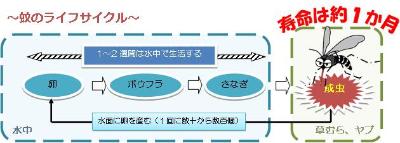Here's the text.
About mosquitoes
Last Updated June 6, 2023
Mosquitoes transmit a variety of infectious diseases, including dengue fever, Zika virus infection, Chikungunya fever, West Nile fever, and Japanese Encephalitis.
In order to prevent mosquito-borne infections, take measures to prevent mosquito bites and increase mosquitoes on a regular basis.
- About mosquito-borne infectious diseases(To Yokohama City Public Health Center website)
Mosquitoes commonly found in Yokohama
Aedes albopictus
It is a mosquito that transmits dengue fever and Zika virus infection.
There is a white pattern in the black. It is a representative of what is commonly called Yabuka.
Blood sucking is mainly in the daytime (especially in the morning and evening).
Kaieka
It has a brownish color.
It doesn't work much during the day and sucks blood at night.
Chika Yeka
We are in a place where urbanization has progressed, such as accumulated water in the basement of the building.
It sucks blood actively in the evening and dawn, but may suck blood even during the day.
It is also active in winter.
The life of a mosquito
Eggs lay on the surface of the water.
The number of spawnings, depending on the type, produces dozens to hundreds at a time.
They live in the water for 1-2 weeks and become adults.

Adults live for about a month, during which time female mosquitoes repeat the blood-sucking-spawning-blooding cycle about 1 to 4 times.
To prevent mosquito bites
Avoid skin exposure
When going to places with lots of mosquitoes, wear long sleeves and long pants to avoid exposing your skin.
Let's use repellent correctly
There are products of various shapes such as insect repellent sprays and lotions, but be sure to check the precautions before using.
Avoid places with mosquitoes
Avoid staying in weeds or in moist, well-ventilated places.
Let's not put mosquitoes into the house
Install screen doors in windows and minimize the opening and closing of doors.
To avoid increasing the number of mosquitoes
Aedes albopictus, which transmits dengue fever and Zika virus infection, is said to have a narrow activity range (around 100m to 150m radius).
Let's reduce the source of mosquitoes around you and create an environment that does not increase mosquitoes.
Measures against larvae (bow hula)
The bow hula also occurs in small puddles.
Eliminate puddles and sort out what causes puddles.
Measures against adults
Adults are in wet, poorly ventilated places, such as in the grass or in yabs.
Let's cut weeds regularly to eliminate mosquito bites.
When using insecticide for bow hula
The use of insecticide can be done efficiently, but the effect is temporary. In addition, excessive spraying can lead to adverse effects on the environment. For sustainable control, it is most important to create an environment where mosquitoes are difficult to live.
When using insecticide to control bow hula, use an insect growth inhibitor (IGR agent), which is said to be less harmful to other organisms, be sure to read the precautions carefully and follow the dosage and use it properly.
List of materials
To prevent or increase mosquito bites (poster: B3 size) (PDF: 885KB)
Watch out for mosquitoes! (Flyer: A4 size x 2) (PDF: 984KB)
If you have any questions about sanitary pests, please contact Health and Welfare Center Health Sanitation Division in your ward.
You may need a separate PDF reader to open a PDF file.
If you do not have it, you can download it free of charge from Adobe.
![]() To download Adobe Acrobat Reader DC
To download Adobe Acrobat Reader DC
Inquiries to this page
Health Sanitation Division, Medical Care Bureau Health and Safety Department
Telephone: 045-671-2456
Telephone: 045-671-2456
Fax: 045-641-6074
Email address: ir-seikatsueisei@city.yokohama.lg.jp
Page ID: 265-044-504







